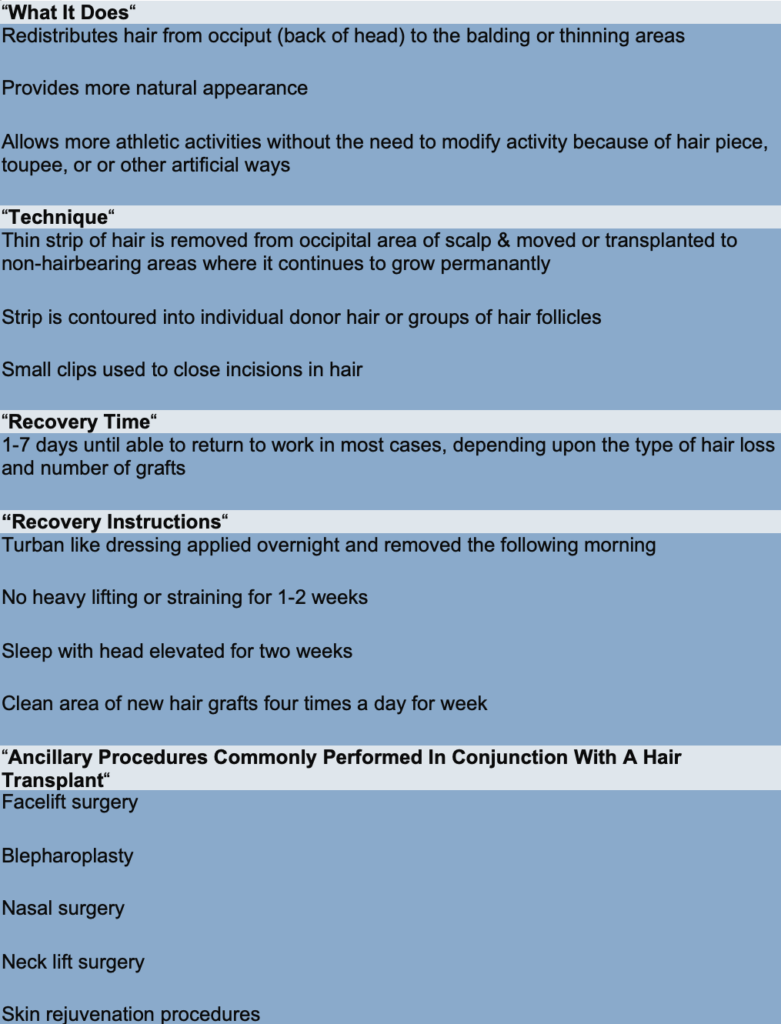
Advances over the past few years have made it possible to shrink wide bald spots, add hair to sparse areas, and create new, natural-looking hairlines.
To date, the most successful method of correcting baldness is to transfer the patient’s own hair from non-bald areas to the areas of hair loss. The procedure for treating baldness might well be more accurately termed “hair redistribution”. This can frequently lead to dramatic results. The results of today’s surgical hair restoration techniques are usually permanent and can be extraordinary. However, treatment often involves multiple visits, and it may take several months to realize the true results. While improvement is often very gratifying, the patient considering hair transplantation should realize that he or she will never be able to obtain a full head of hair comparable to their pre-balding condition.
Today, many individuals wish to take action at an earlier age and stay ahead of their beginning hair loss by adding fullness and density to thinning areas a little at a time. This results in the grafts being virtually undetectable. One is able to camouflage the newly growing transplanted hairs with their existing hair. This enables one to allow the newly growing transplanted hair to stay subtle and unobtrusive between procedures. This is increasingly important to many individuals, but especially to the growing number of individuals from high-profile business, professional, political, and entertainment fields.
Most patients desire a very natural look. For some, it is a desire to have a thickening of thinning areas subtly over the course of several procedures. On the other hand, some individuals are seeking to have a hairline recreated on a balding scalp. For these individuals, the new advanced techniques allow a more natural look with low visibility graft patterns that replace the traditional “row structure” or “cornstalk” look associated with older hair transplantation techniques.
We have all heard people comment that they have not seen “any good-looking hair transplants”. They state that the only hair transplants they see are “obvious” and look “pluggy”. We have all seen men with hair transplants that look like dolls’ hair or rows of corn in the front. Fortunately, there have been tremendous advances in the field of hair restoration. Today, we are able to create more natural-appearing hairlines that decrease the visibility and detectability of hair transplantation. It is an ironic fact that the better the hair restoration technique, the less people notice. This is what we strive for. However, it does mean that probably only a hair restoration expert might be able to detect their transplants. For this reason, most people only notice the bad hair transplant results and, therefore, there is still a common misperception that this is the typical type of result that is achieved with modern hair restoration techniques. Nothing could be further from the truth.
There are seven classifications of baldness, with Class I being normal hair growth and Class VII being the typical horseshoe-shaped baldness. Less than 30% of individuals who have significant hair loss proceed to the Class VII type of baldness. The best indication of whether someone will proceed to that extent is to look at the individual’s father and/or grandfather, since there is a hereditary tendency. It should be noted that individuals will not lose the hair in the posterior occipital area. Hairs taken from this area can be transplanted to the frontal area, and they continue to grow, despite hair loss in other areas.
These individuals have no appreciable hair loss. They are not candidates for surgical hair restoration or artificial hairpieces. If individuals start to experience early hair loss, they may desire to seek drug therapy in the effort to prevent some future hair loss. This will be effective in a very small percentage of men.
These individuals experience early hair loss in the frontal temporal areas which can become severe in future years. These individuals may desire hair transplantation early in order to avoid detectability and negate adverse effects of advancing hair loss. Not all are candidates and this is determined at the consultation, taking into consideration the patient’s age, family history, amount of hair loss, and the type and texture of one’s hair.
These individuals have a more advanced stage of hair loss with thinning in the frontal temporal areas, which is more advanced than Class II. In more advanced stages, there can be thinning or even balding on the crown of the scalp. In most cases, these individuals are excellent candidates for hair restoration, utilizing mini- and micro-graft techniques.
Men with Class IV hair loss have significant hair loss, which results in severe frontal temporal recession. There are enlarging areas of hair loss on the crown area, which results in a “bald spot.” These individuals may use an artificial hairpiece or may choose to proceed with hair restoration to create a more natural frontal hairline. In some cases, grafts or scalp reduction techniques can be used to treat the “bald spot” on the crown area of the scalp.
Class V hair loss is very significant hair loss in the frontal area. In early stages, there can be a “bridge” of hair between the bald area on the crown of the scalp and the frontal area. However, this usually thins very quickly and results in the early stages of the so-called “horseshoe-shaped” baldness. Artificial hair transplants may be utilized by some individuals. Other may choose a more natural, permanent restoration utilizing hair transplantation independently or in combination with scalp reduction. In some cases, individuals prefer to have just the frontal hairline and frontal scalp area restored, leaving a bald area on the crown. In other instances, they desire to have all areas treated. The doctor will be able to determine whether or not an individual in Class V is a candidate for hair restoration utilizing these procedures. This is based upon the patient’s age, family history, amount of hair loss, type and texture of hair, and the amount of donor hair available.
Men with Class VI hair loss have very severe balding. There is significant hair loss in the frontal area with balding on the crown of the scalp. These individuals may choose to utilize artificial hairpieces. Others may be candidates for hair restoration utilizing hair transplantation techniques alone or possibly in combination with scalp reduction, which removes portions of the bald scalp. This allows a small number of hair grafts to more effectively cover larger areas. Again, it is important for men in the Class VI hair loss stage to be thoroughly evaluated to determine whether or not they are a candidate for hair restoration procedures.
Men in Class VII have the most advanced stage of hair loss and typically have the “horseshoe” shaped appearance with a thin band of hair around the perimeter of the scalp. These individuals are not candidates for surgical hair restoration techniques. However, they are excellent candidates for artificial hairpieces.Hair transplant surgery is usually done on an outpatient basis. Because it is simply involving removal of bald areas of scalp and transplanting some grafts of skin containing hair follicles, it is usually considered a minor surgical procedure. Surgery is performed in the surgical suite. While most individuals have “twilight” anesthesia, the procedure can be done entirely under local anesthetic.Individuals wash their hair prior to surgery with a mild antibiotic shampoo. After the patient is properly sedated and anesthetized, a linear strip of hair is removed with special instruments from the posterior, or occipital, portion of the scalp. Harvesting of excess hairs from the transplant donor area in the very back or along the sides of the head can be done in such a way that, in most cases, it is very difficult to detect where grafts have been taken from. The technique we utilize minimizes the amount of scarring and detectability as well as minimizing the waste of precious donor hair. After removing the strip of hair, the edges are closed with special sutures, which leave only one or two faint lines that are immediately covered by the surrounding hair. This technique is not only cosmetically beneficial, it also maximizes the number of hair grafts available as compared to old-fashioned techniques.
Utilizing special instrumentation and magnification, small grafts are created, consisting of 1-2 hair micrografts and 2-6 minigrafts. Special instruments are then used to remove the balding skin. The newly created grafts are then positioned in the new recipient site and positioned precisely to grow together at the angle and in the direction that closely restores your original hair pattern. This results in hair restoration that is specifically customized for you. By creating a gradual transition zone with 1-2 hair grafts and gradually moving into larger grafts, a very natural hairline is created.After a brief resting period, the transplanted hair in the new hair zone begins to grow and will continue to grow for the rest of your life. It has been said that hair transplantation is an investment that keeps growing!
Following surgery, your hair is washed and bandages placed over the area to secure the grafts in place. A stocking cap is then placed to camouflage and secure the dressing in place. The patient then goes to the recovery area and is released. Patients can remain in the Center overnight in our recovery area facility or can return home. They are seen in the Center the next day for a dressing change. Most individuals find that they are able to resume their normal activities with 3-4 days. For the first 7-10 days, the newly grafted areas are cleaned with hydrogen peroxide and frequent showering.
After approximately eight weeks, the transplanted hairs fall out to make room for the new hairs, which are emerging from the newly transplanted roots. This follows each of the hair transplant procedures and should cause no alarm. This process is similar to a young child shedding his primary or “baby” teeth in order to make room for the adult teeth. At any given time, the scalp contains hairs of many different ages. Beginning the day we are born, the hair undergoes a normal shedding process, whereby an existing hair falls out and new hair replaces it. The transplantation procedure produces a “shock” to the roots of the graft so that, after approximately eight weeks, all the hair in the graft will gradually fall out to make room for the new hairs. In very rare circumstances, hair in the grafts continue to grow and do not fall out. However, this is the exception rather than the rule.
Once new hairs from the transplant graft reach the surface of the skin, they usually grow at approximately one-half inch per month. Male hair needs to be approximately 1-1/2 inches long before it can be appropriately styled. Thus, it takes approximately 4-6 months before we obtain the final aesthetic result from a graft. We usually wait approximately 3-4 months between hair transplant sessions in order to allow the transplanted grafts to obtain a good blood supply and to be able to identify the new growth in order to most effectively place additional grafts.
It is important to note that multiple procedures may be necessary in order to obtain the most desired result. Some of our patients who consider themselves “perfectionists” want to have additional blending and thickening procedures behind the frontal hairline in order to achieve the maximum density possible. Individuals can even obtain additional “softening” of the frontal hairline with additional micrografts. All of this depends upon the patient’s individual desires as well as their hair type, texture, and amount and quality of donor hair available.


Schedule a Consultation
Communication is not secure. Contacting the practice does not establish a physician/ patient relationship.*